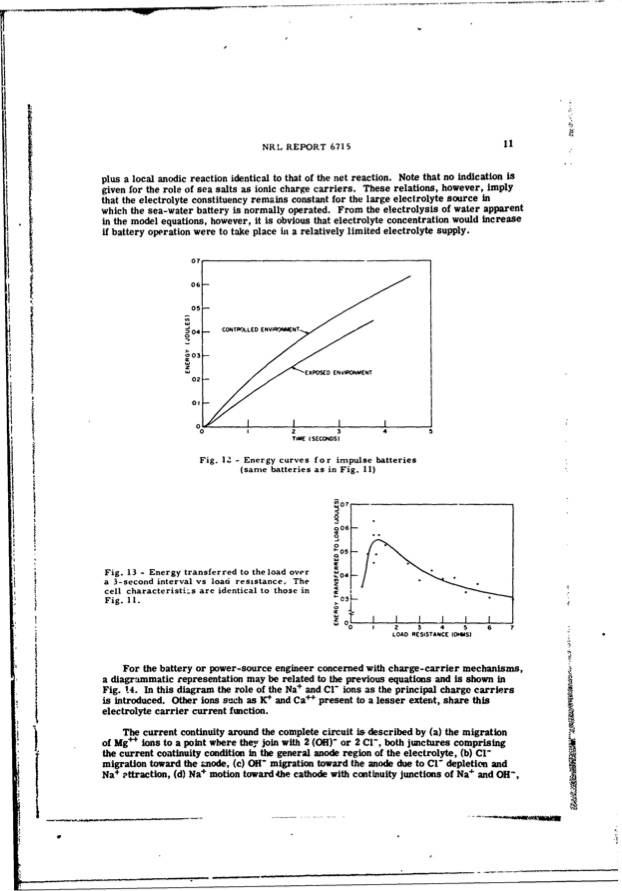
PDF Publication Title:
Text from PDF Page: 014
*Iin I NRL REPORT 6715 1 plus a local anodic reaction identical to that of the net reaction. Note that no indication is given for the role of sea salts as ionic charge carriers. These relations, however, imply that the electrolyte constituency remains constant for the large electrolyte source in which the sea-water battery is normally operated. From the electrolysis of water apparent the model equations, however, it is obvious that electrolyte concentration would increase if battery operation were to take place ii a relatively limited electrolyte supply. 0? 06r 05- hi 0M04 -CONTROLLED S03 iEXPOSED 02 01- ENV0MV0*N0NT 0I 2 3 4 TIME (SECONDS) Fig. 1U - Energy curves (same batteries Fig. 13 - Energy transferred to theload over a 3-second interval vs load resistance, The cell characteristizs are identical to those in Fig. 11. for impulse batteries as in Fig. 11) a06 -- W04 z• o_0 2345•6 . LOAD RESISTANCE (OHMS) For the battery or power-source engineer concerned with charge-carrier mechanisms, a diagrammatic representation may be related to the previous equations and is shown in Fig. 14. In this diagram the role of the Na+ and CI- ions as the principal charge carriers is introduced. Other ions such as KV and Cat+present to a lesser extent, share this electrolyte carrier current function. The current continuity around the complete circuit is described by (a) the migration of Mg++ ions to a point where they join with 2 (OH)- or 2 C1-, both junctures comprising the current continuity condition in the general anode region of the electrolyte, (b) Cl" migration toward the Lnode, (c) OH" migration toward the anode due to CI" depletion and Na÷ ,ttraction, (d) Nat motion toward 4he cathode with continuity junctions of Nae and OH-, ENVoIONMENT -'PDF Image | INERT-CATHODE SEA-WATER BATTERY

PDF Search Title:
INERT-CATHODE SEA-WATER BATTERYOriginal File Name Searched:
AD0673399.pdfDIY PDF Search: Google It | Yahoo | Bing
Product and Development Focus for Salgenx
Redox Flow Battery Technology: With the advent of the new USA tax credits for producing and selling batteries ($35/kW) we are focussing on a simple flow battery using shipping containers as the modular electrolyte storage units with tax credits up to $140,000 per system. Our main focus is on the salt battery. This battery can be used for both thermal and electrical storage applications. We call it the Cogeneration Battery or Cogen Battery. One project is converting salt (brine) based water conditioners to simultaneously produce power. In addition, there are many opportunities to extract Lithium from brine (salt lakes, groundwater, and producer water).Salt water or brine are huge sources for lithium. Most of the worlds lithium is acquired from a brine source. It's even in seawater in a low concentration. Brine is also a byproduct of huge powerplants, which can now use that as an electrolyte and a huge flow battery (which allows storage at the source).We welcome any business and equipment inquiries, as well as licensing our flow battery manufacturing.| CONTACT TEL: 608-238-6001 Email: greg@salgenx.com | RSS | AMP |